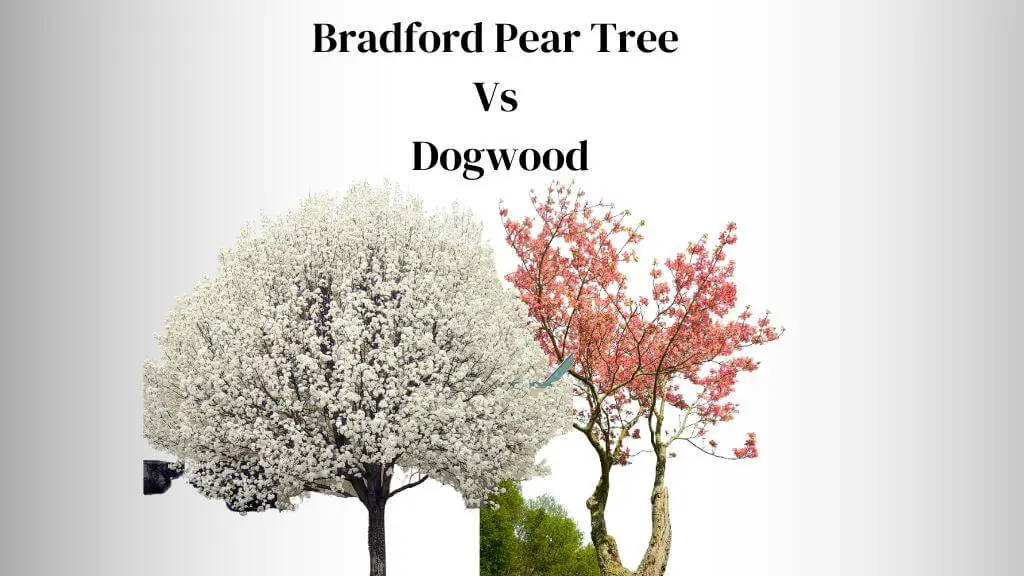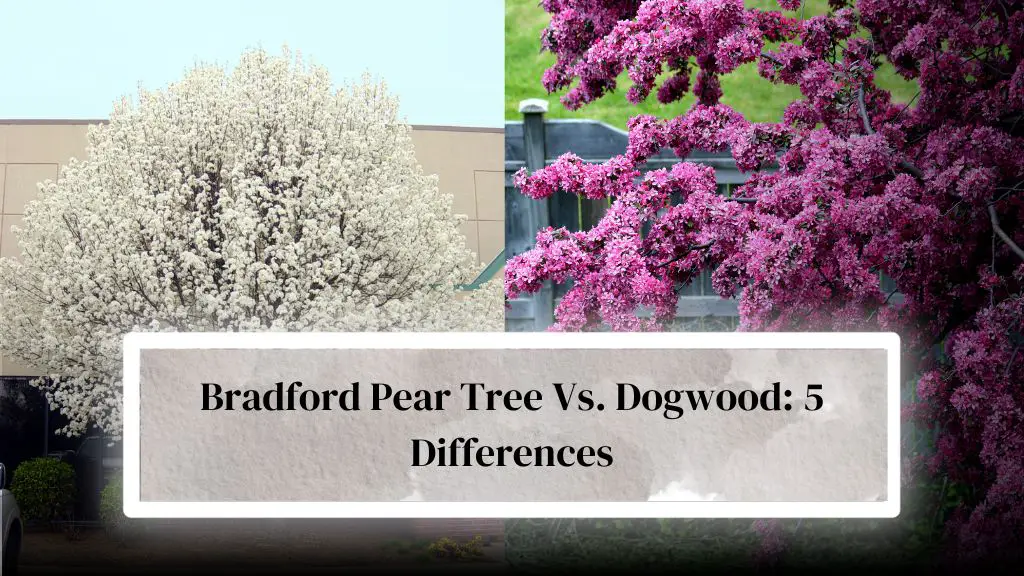
Are you considering planting a tree in your yard but need help deciding between a Dogwood or a Bradford Pear? Both are popular choices, but they have unique differences that may make one more suitable for your landscape than the other.
This article will explore five key differences between Bradford Pear Tree Vs Dogwood, including their appearance, climate, soil tolerance, growth rate, and maintenance requirements.
Additionally, we will delve into seven more key differences between Dogwood Tree Vs Bradford Pear, like blooming season, attractiveness to wildlife, and landscape design, to help you make an informed decision. So, let’s dive in and find out which tree best fits your yard!
Bradford Pear Tree Vs Dogwood: 5 differences

Appearance: What Makes Them Different?
The Dogwood Tree and the Bradford Pear Tree are lovely trees with distinctive characteristics. The Bradford Pear, commonly called the Callery Pear, is a deciduous tree that can reach heights of 50 feet.
It has a pyramidal structure is known for its springtime blooms of thick, white flowers. The lustrous, dark green foliage of the Bradford Pear Tree turns vivid scarlet in the autumn.
On the other hand, the Dogwood Tree is a tiny deciduous tree that can reach a height of 30 feet. It is a spherical plant that blooms in the spring with lovely white, pink, or red flowers.
The dogwood tree’s lustrous, dark green leaves become scarlet or purple in the autumn. Overall, the Dogwood Tree is smaller and more rounded, whereas the Bradford Pear Tree is higher and more pyramidal.
Climate Tolerance: Which Tree Can Handle Extreme Weather?
When it comes to climate tolerance, the Dogwood Tree is the winner. It can grow in hardiness zones 5 through 9, making it suitable for most parts of the United States.
The Dogwood Tree can tolerate cold temperatures and hot, humid summers. In contrast, the Bradford Pear Tree is more sensitive to extreme weather conditions.
It can only grow in hardiness zones 5 through 9, making it unsuitable for areas with harsh winters or scorching summers. The Bradford Pear Tree’s weak wood is also prone to breakage during strong winds or storms.
However, you can use its wood for fire. To know more, check out “Is bradford pear good firewood?“. If you experience extreme weather conditions in a particular area, you should avoid planting Bradford pear trees.
Soil Tolerance: Which Tree Can Grow in Various Soil Types?
Undoubtedly, The Dogwood Tree is more tolerant of different soil types than the Bradford Pear Tree. It can grow in acidic, alkaline, or neutral soils and adapt to various soil textures, including loam, clay, and sand.
On the other hand, the Bradford Pear Tree prefers well-drained soils and is sensitive to poorly drained or compacted soils. Bradford pear tree has also been noticed struggling in acidic or alkaline soils.
Growth Rate: Which Tree Grows Faster?
The Bradford Pear Tree is a faster-growing tree, growing up to 3 feet per year. It can reach its mature height of 30 to 50 feet within 20 years (contributing to weak wood).
To know more about their wood quality, check: Is Bradford Pear a Hardwood?. The Dogwood Tree, on the other hand, grows slower, only up to 1 foot per year. It takes longer for the Dogwood Tree to reach its mature height of 20 to 30 feet.
Maintenance: Which Tree Requires More Care?
The Bradford Pear Tree and Dogwood Tree require some maintenance, but the Bradford Pear Tree is more high maintenance. You must provide regular pruning to maintain its shape and prevent breakage, especially during storms.
The Bradford Pear Tree is also susceptible to diseases, including fire blight, pear scab, and pests like borers and scale insects. The Dogwood Tree, on the other hand, is less susceptible to diseases and pests.
You need to give occasional pruning to remove dead or diseased branches & maintain their shape. Sometimes a diseased tree may require complete removal from the ground. If this is the case, here is “how much to remove a Bradford pear tree.“
Dogwood Tree Vs Bradford Pear: 7 More Key Differences

Comparison of Blooming Season
One of the biggest differences between the Bradford Pear Tree and the Dogwood is their blooming season. The Bradford Pear Tree typically blooms in early spring, with clusters of white flowers covering the tree, which only last for a week or two.
However, these specimens are incredibly showy and can dramatically impact your landscape. If you’re interested to learn more, here’s an article covering “When Do Bradford Pear Trees Bloom?“.
The Dogwood, however, typically blooms in late spring or early summer, with pink or white flowers covering the tree. Fortunately, this particular species blooms last longer than those of the Bradford Pear Tree, sometimes lasting up to four weeks.
While the blooms of the Dogwood may not be as dramatic as those of the Bradford Pear Tree, they are still quite beautiful and can add a soft, romantic touch to your landscape.
Comparison of Attractiveness to Wildlife
Both the Bradford Pear Tree & the Dogwood are known to be attractive to wildlife but in different ways.
You should know that Bradford Pear Tree does not produce fruit, so it is not particularly attractive to birds or other animals that rely on fruit for food. To know more, consider reading “Bradford Pear Tree Fruit Edible: Effects, Risks & Precautions” However, the tree’s flowers can attract bees and other pollinators.
Dogwood, conversely, is known to produce small red fruits that are attractive to birds. Their flowers are also known to attract pollinators, & beneficial insects, but the fruit is the real draw for wildlife. If you want to attract birds to your yard, the Dogwood may be a better choice than the Bradford Pear Tree.
Comparison of Landscape Design
Both the Bradford Pear Tree & the Dogwood can be beautiful additions to any landscape, but they have different design characteristics. The Bradford Pear Tree is a fast-growing, upright tree that can reach heights of up to 40 feet with a symmetrical shape and dense foliage that can provide shade & privacy.
On the other hand, The Dogwood is a smaller tree that Bradford typically grows to a height of 20 to 30 feet. It will have a more irregular shape & branching pattern, and its foliage will be more open & airy. The Dogwood can be a great choice for smaller yards or as an accent tree in a larger landscape.
Comparison of Cost.
The cost of a Bradford Pear Tree or a Dogwood can vary depending on the size of the tree & where you purchase it. Generally speaking, the Bradford Pear Tree is less expensive than the Dogwood, particularly when comparing similar trees. The Bradford Pear Tree is more widely available and easier to propagate.
Comparison of Pros and Cons
Bradford pear trees are Fast-growing trees that hold symmetrical shapes with dense foliage, whereas dogwood trees are known for their beautiful blooms & fall foliage that are attractive to birds of smaller sizes. However, both of them also have some downsides.
Bradford pear trees are Susceptible to storm damage that comes with a short lifespan, & emit an unpleasant smell from their flowers. To know more, you can check “Do Bradford Pears Stink?” or “Why Do Bradford Pear Trees Smell Bad.” On the other hand, dogwoods are also slow growers that can be susceptible to disease & pests, but they are more expensive than Bradford Pear Tree.
Comparison of Diseases and Pests
Although the Dogwood and the Bradford Pear Tree have different problems, both can be vulnerable to disease and pests. Storm damage can result in disease and pests, and the Bradford pear tree is especially vulnerable to these problems.
Additionally, the tree is prone to fire blight, a bacterial disease that can be fatal. In contrast, Dogwood is prone to several ailments, such as powdery mildew, anthracnose, and dogwood borer.
The health and beauty of the tree may be affected by several diseases, which can also result in stem cankers and leaf drops. In addition, Dogwood may be vulnerable to pests like spider mites and scale insects.
Flowering Dogwood Tree Dogwood Vs Bradford Pear: Which Is Better?
Regarding landscape design, the Flowering Dogwood Tree is a popular choice for small to medium-sized yards due to its smaller size and irregular, open growth habit. You can use this tree as a focal point or plant in groups for a naturalized look.
The Bradford Pear Tree, on the other hand, has a more upright, symmetrical growth habit that can provide shade & privacy if you plant them in rows or along property lines. When it comes to cost, the Flowering Dogwood Tree is more expensive than the Bradford Pear Tree due to its slower growth rate & shorter lifespan.
However, Dogwood’s aesthetic appeal and ability to attract wildlife can make it a worthwhile investment for those looking to enhance their landscape. Regarding potential
diseases & pests, the Flowering Dogwood Tree can be susceptible to several issues, including powdery mildew, anthracnose, and dogwood borer.
On the other hand, the Bradford Pear Tree can be susceptible to pear psylla, a small insect that can cause damage to the leaves and shoots. The choice between the Flowering Dogwood Tree and the Bradford Pear Tree will ultimately depend on your preferences and needs.
The Dogwood may be the way to go if you’re looking for a tree with beautiful, colorful blooms and a naturalistic growth habit. However, if you’re looking for a fast-growing, symmetrical tree that provides shade and privacy, the Bradford Pear Tree may be a better choice.
Conclusion
I have given my best to give you a proper difference between dogwood trees and Bradford Pear Trees. If you find this article helpful, then consider sharing. Your share will not only help people learn about the actual difference between them but also help them make a wiser choice between the two.
The Bradford Pear Tree may be the best option if you’re searching for a fast-growing, symmetrical tree that offers shade & privacy. The Dogwood, however, would be a great option if you’re looking for a smaller tree that draws birds and has lovely blossoms & autumn colors.
Whichever tree you select, take adequate care of it to ensure its health and growth for many years to come. Do check our other helpful guide on Bradford Pear Tree care & management. See you in the next post, till then, take care & goodbye.
